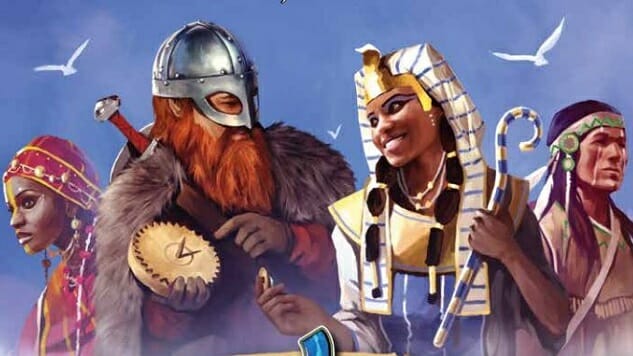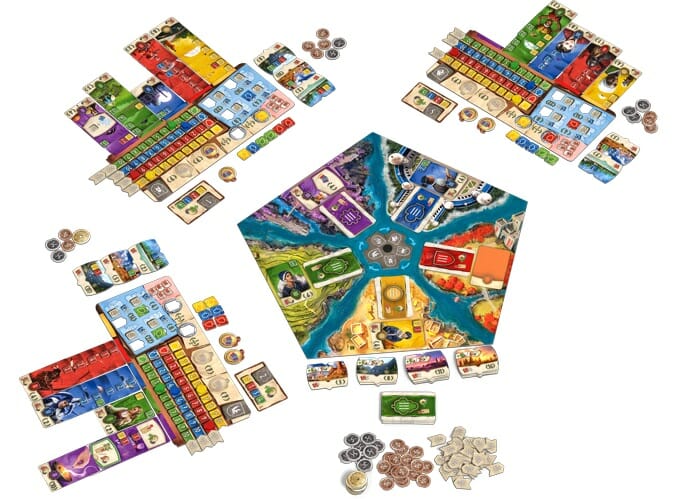Civilization Is Yours for the Building in the Almost Too Clever Board Game Hadara
Art courtesy of Z-Man Games Games Reviews board games
Hadara made my top ten list for 2019 and is already the game I recommend to people who like 7 Wonders but want something different or something that isn’t over quite as quickly. While 7 Wonders is still my favorite game, Hadara manages to capture a lot of what’s good about it, with a few new quirks of its own, suffering just a little from one or two twists too many.
Hadara is a card-drafting and civilization-building game where you’ll buy and sell cards over the course of three “epochs,” building a tableau for points and to move your four civilization tracks. As in 7 Wonders, you don’t collect actual resources other than money; in Hadara, you can only buy cards with coins, as there are no resources at all and there’s no tech tree to get you cards in later epochs for free. Instead, you’ll use the tracks to gain other benefits outside of the card-drafting phases.
Each epoch has two separate phases where you’ll gather cards. The board has five stacks of cards, in the four track colors as well as purple cards, face-down around a central wheel. On a turn in phase A, each player simultaneously takes the top two cards from the stack adjacent to their player symbol. They must choose one card to discard to the board, making it available in the second phase. The remaining card can be bought for its price, shown on the front of the card, or sold—and removed from the game completely—for the price shown on the back, which is two, three or four coins depending on the epoch. The wheel makes a full rotation on the board in Phase A of each epoch, so each player will get to make the buy/sell decision five times, once per card stack (and color).
At the end of Phase A, each player then gets coins equal to the number shown on their yellow (income) track, and then has two optional decisions. If the player’s red (military) track meets any of the five thresholds for acquiring a colony token, the player may do so, and then pay one, two or four coins to flip it to reveal its benefits, which will let the player move up on one or more of their tracks and give the player victory points at game-end. (The player can choose not to flip the colony and take an immediate payout in coins, but I still can’t see when this would be the optimal choice.) Then, if the player’s blue (culture) track meets any of the four thresholds for building a statue, the player may do so, gaining victory points and moving up one track of the player’s choice by two or more spots.
In Phase B, players go around the table and choose one card from the top of the discard piles—you can’t root through any of the piles—and may buy or sell it as in Phase A. This continues until all piles are exhausted, after which players collect income again and may choose to acquire a colony or build a statue. Phase B has two more steps: Each player must check to ensure their green tracker (food/agriculture) is at least as high as the number of cards in their tableau; if not, they can’t feed their people and must return cards until the two numbers match.

Finally, players may choose to buy medals at the end of each epoch—the one rule I found to be a bit too much. Silver medals let the player score points at game-end equal to one-half the number on the track of their choosing. Gold medals give the player seven points for each complete set of cards, meaning one card in each color. You can buy up to two silver medals, for the same color or different ones, and up to two gold medals, which would make each set of five cards in all colors worth 14 points apiece. Medals are cheap after epoch one but become very dear after epoch three, so there’s value in buying them early, but it’ll probably use up most or all of the coins you had heading into the next epoch.
Cards become more expensive and also more powerful for epoch two, and again for epoch three. The purple deck also includes some ‘advanced’ cards that you may use once you’re a bit more familiar with the game; they enhance scoring in various ways rather than moving you up the trackers. Thus ensuring you have enough income to be able to continue to buy cards in subsequent epochs—since the return from selling a card is always too modest to just let you buy the next card—is as key as making sure you have enough food on the green track.
The biggest decisions in Hadara revolve around the statues and the silver medals. You start the game with eight square(ish) tokens, two for each track color. When you build a statue, you pick one of those tokens and put it in the open space next to that statue. You do the same when building a silver medal. Since you have just two tokens of each color, you will have to make some choices early in the game, and may end up unable to buy a silver medal in your strongest color if you’ve already used those tokens.
Hadara is generally fun and fast-moving, with just a bit of engine-building and lots of little decisions to keep your brain involved. That said, the game feels a bit like it’s 10% too clever. At game-end, you add up the points from all of the cards in your tableau, the points from your colonies and statues, the points from your medals, and one point for every five coins you have left over. The medals don’t work with the game’s overall theme (you get medals for a civilization?) and they’re nowhere near as well integrated with the other ways you score—yet if you play them well, they can easily be the difference between winning and losing. The one time I played this with five players, I won specifically because I had bought two gold medals, while the other players hadn’t focused as much on medals because they seemed so tangential to the core game—but the game is also more fun with more players because you get more cards in play.
The other small negative to Hadara is that very little of it is interactive—your progress on tracks is independent of other players’, and because colony selection is simply random (you take the one at the top of the stack), there’s no advantage to buying a colony first beyond getting the movement on your tracks. The one truly interactive component is in Phase B, when you choose cards from the face-up piles on the board; you might find it useful to take a card another player clearly needs, even just to sell it and remove it from the game. That is valuable, in my experience, but beyond that Hadara is a bit of a solitary endeavor—but a solid one, and perfect if you love 7 Wonders and want something in a similar vein.
Keith Law is the author of Smart Baseball and a senior baseball writer for The Athletic. His latest book, The Inside Game, is due out in April 2020. You can find his personal blog the dish, covering games, literature, and more, at meadowparty.com/blog.